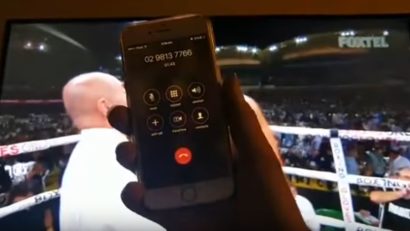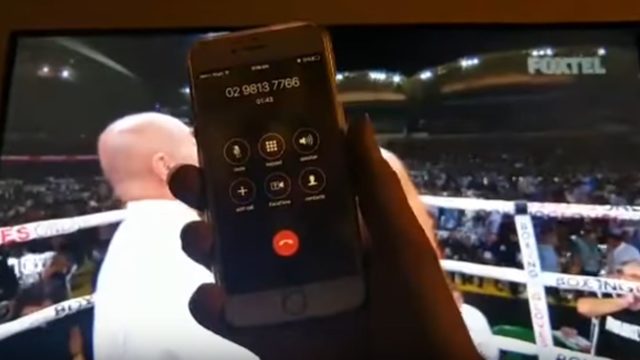In the next couple of months, you'll be hearing more and more about a new technology that Telstra is switching on around the nation at the start of 2015. 4GX is just a fancy name for the telco's new 700MHz mobile network frequency, but that's not the only thing you need to know about it.
Telstra is set to switch on its 700MHz frequency allocation on January 1, 2015 — that's the date that it is officially allowed to use the spectrum, as part of the agreement it made with the Federal Government when it purchased it at the Digital Dividend auctions. There are a few sites around the country, especially around inner-city Sydney, where pre-release trial sites are set up and already functioning, but for the most part the go-live date is January 1.
We first saw the name '4GX' on a Telstra Exchange blog post announcing the Sony Xperia Z3 and Xperia Z3 Compact (which, by the way, is a great phone).
It's Much Faster
Telstra's 700MHz allocation, which it purchased at auction (along with a significant chunk of 2500MHz) in May last year for $1.3 billion, is for two 20MHz segments of the frequency band — the majority of that frequency, and double the space of Optus's two 10MHz segments. It's in the APT700 band segment, which is becoming increasingly popular around the world — an important consideration for any telco considering adding new devices.
Being twice the bandwidth of Telstra's existing 1800MHz and 900MHz allocations, you can reasonably expect theoretical and practical download speeds to double, or even more, when you're using a 700MHz device. Telstra quotes 2Mbps to 75Mbps speeds for 4GX Category 4 devices — that's the LG G3s, Samsung Galaxy S5s, Sony Xperia Z3s and iPhone 6s that are already out in Australia. The 700MHz portion of the spectrum was previously used for analog TV signals, so it's good to see it going to very good use.
It Won't Work On All Phones
Not too many phones, tablets and 4G hotspots that have been launched in Australia support Telstra's 700MHz network, the frequency that is going to be called 4GX by the telco itself. That compatibility, for the most part, is restricted to more recent and more high-end handsets, and a few premium hotspots that Telstra sells exclusively. As time goes on, more devices are and will be released that support the new standard, but especially while it's new there won't be that many people using it.
That's a great thing for early adopters, who will enjoy massively improved speed — not only because of the 700MHz network's technical advantage over 900MHz and 1800MHz, but because there'll be fewer people contending for the same amount of bandwidth on any one mobile phone tower. As time goes on, speeds will level out to more reasonable and realistic rates, but when more handsets move to 700MHz it'll free up the other bands as well — everybody wins.
This is nowhere near a conclusive list, and it'll expand on a weekly basis as more devices are released, but here are most of the 700MHz, Telstra 4GX-capable devices you can buy in Australia as of today:
- Samsung Galaxy S5
- HTC One (M8)
- LG G3
- HTC Desire 610
- Samsung Galaxy Note 4
- Apple iPhone 6
- Apple iPhone 6 Plus
- Telstra Wi-Fi 4G Advanced Pro X (Netgear Aircard 782S)
- Telstra 4G My Pocket Ultimate Wi-Fi (Netgear Aircard 785S)
- Telstra 4G My Pocket Plus (Netgear Aircard 785S)
- Alcatel Pop S3
- Kogan Agora 4G
It's A Crucial Part Of Telstra's Next-Gen Network
The APT700 band — that's 4GX — forms one half of Telstra's fledgling LTE-Advanced Category 6 mobile data network, which will fuse together data channels from 700MHz and 1800MHz frequencies to further accelerate download speeds. In trials, Telstra has hit 450Mbps download rates on LTE-A, which is three times the theoretical limit of a single 4G band.
Telstra has also come out to say that wherever it deploys 700MHz, LTE-Advanced will be available. (That LTE-Advanced will also need an 1800MHz frequency band available and connected, too, for what it's worth.) So, if you're using one of two devices — the new Galaxy Note 4, or the Telstra Wi-Fi 4G Advanced Pro X (above) — you'll be able to hook up to LTE-Advanced and 700MHz alike as soon as it switches on.
You Might Already Be Using It
Telstra has 700MHz networks up and running, on a trial basis, and thanks to a bit of wheeling and dealing with ACMA and the government, in these locations already:
Surry Hills, Haymarket, Chippendale, Redfern, Waterloo, Zetland, Kensington, Alexandria, Erskineville, Eveleigh, Moore Park, Beaconsfield, Rushcutters Bay, Elizabeth Bay, Balmain East, Balmain, Birchgrove, Woolwich, McMahon's Point, Lavender Bay, Milsons Point, Kurraba Point, and Neutral Bay.
as well as:
parts of Sydney, Adelaide, Darwin, Sarina, Yamba and Bundaberg
with "20 more locations" being added before the end of the year. If you have one of the phones listed above, and you're in one of the areas listed here, then chances are you're using 700MHz already and not even realising. When it launches more widely — to 50 regional locations, and to cover a 3km radius around all of Australia's capital cities' CBD areas — it'll cover more customers again.
It's Not The Only Next-Gen Network
Optus bought a chunk of 700MHz too, and Optus is also planning its own 700MHz and LTE-Advanced network roll-out at the same time as Telstra is.
You don't necessarily need to use Telstra's 4GX to get yourself onto a next-gen 4G network; we'll leave you to decide which is best for your needs, which is the most technologically advanced, and which is the best value.





















Comments
Alcatel Pop s3 also picks it up - not bad for a $199 prepaid.
I think you can only get it prepaid on Optus :P
They're going to need to start increasing download quotas. You could burn through the current quota in a matter of minutes at those speeds.
Didn't you know they make most of their profit in dodgy excess data charges? It's all part of the plan...
While that would be nice, having higher download speeds doesn't mean people have to use any more data, just that whatever they access is available in a more timely fashion.
I can't see many consumers suddenly downloading ISO's or HD movies over a mobile device just because its now quicker to do so than it was previously.
Oh yes, because everyone has access to fixed line broadband to download ISOs and HD movies with!
I stream from Spotify quite often, and videos from YouTube or Vimeo take a fair bit of data. If you're a daily public transport commuter, the quota could be used up pretty quickly if you watched stuff to and from work. I occasionally like to watch the odd TED video or whatnot, but many times I've come a little too close to hitting my 1gb limit.
Especially for the dongles and people who rely on 3/4G as their sole method of internet access. $90 per month for 15 GB is insanity.
What Telstra plan isn't insanity? None of their pricing is even close to competitive on anything.
Don`t trust Telstra to deliver anything close to what they promise and as you will notice they are not giving us a definitive download speed.
They simply say that 4GX is twice as fast.
So in Perth where during peak periods I was lucky to connect to......
I might connectnow with their new superfast 700Mhz bandwidth.Telstra 4GX-capable devices you can buy in Australia as of today:
Samsung Galaxy Note 4
Please tell me where I can get the note 4 in Australia today? :p
Oh yeah, good point! :)
It's, um, imminent. I can't wait!
It's also part of the bandwidth that covered wireless microphones, people have already found Telstra tests interrupting microphones during gigs.
The people that this will be affecting should already know about it.
I know that schools have been getting emails about this and to replace wireless microphones that use a different frequencies
Interestingly, the mikes where supposed to be OK until December, which it is not yet : http://www.acma.gov.au/Citizen/Consumer-info/All-about-spectrum/Wireless-microphones/new-arrangements-for-wireless-microphones, I call dodgy on Telstra deploying early in inner-Sydney locations where there are lots of wireless setups ... the so called "dividend" is costing wireless mike users in the order of hundreds of millions, uncompensated.
It would be really great if the "4G" on my iPhone 6 display switched to "4GX" (or whatever the actual technology is called) when it was using that spectrum so that we'd know.
Last edited 06/10/14 12:42 amNo it wouldn't. "4GX" is a marketing term which would only serve to confuse users.
It would be nice if the iPhone displayed the technology in use however (e.g. LTE-A)
Yep or that. Whatever. Point is that if it switches to something other than mainstream 4G, it would be good to know by way of some kind of icon on the display. :)
Last edited 06/10/14 12:45 amIt's impossible for Apple or any vendor to cater every market term regarding every single "new" feature. It's bad enough with the 4G/LTE situation in NA, and that's a simple one compared to what you are saying.
You are basically asking them to expose which spectrum is being used and that's really stupid. Why would you want that? The only thing that matters is speed/coverage, you won't notice any difference between 1800/700 other than stronger signal at some locations. Do we really need a special indicator just for "stronger signals"?
Yes we do. Thanks for your input though. Bye.
Also the galaxy s4 9506 which is also LTE cat 4.
No it's not. It doesn't do any kind of 700MHz, not even US700, I don't know where the confusion is from.
LTE cat4 is about 20MHz channel support, not specific to 700MHz band, nor is it a requirement for cat4.
Where 20MHz contiguous spectrum is available, cat4 is able to provide a significant improvement. With LTE-A and cat6 this is even more so using both 1800 and 700MHz.
Just another hyped up branding term that is only going to confuse the average consumer.
Is there a coverage map available for where this will be available or will be over time? It's possibly a small hope, but I'd be awfully happy if they've included Canberra as one of their "regional" locations. Every coverage map I could find on the Telstra site lead me to the existing 4G networks coverage, not differentiating between 4GX locations.
Did you forget an important part to go with this article? Wouldn't 700MHz theoretically provide better coverage than 850MHz NextG? That's a big thing for all areas if you ever struggle for coverage.
I wondered the exact same thing. That is my understanding of that frequency as well.
Yeah, you're both totally right. I meant to talk about that in the section with the coverage map, then ran out of time before posting...
For the list of phones:
Kogan Agora 4G
I'm still using 3G because it's more cost effective. I pay 26 dollars and get 5gb of data, a sh#t load of calls and text. It might be slower but for day to day stuff it's fine. Go straight into Wi-Fi when I get home and speed picks up but not by that much. Less and less people are on 3G so speeds pick up over time anyway.
According to Luke's earlier article, you can add the Lumia 830 to the list of devices supporting the 700MHz band.
So the Sony Z phones are mentioned a few times in the article, but not in the list? What's up with those, are they half born or something?
The Nexus 6 also supports LTE 700mhz
Just to clarify, which LTE band is this on?
Last edited 03/11/14 6:16 pmMy Nexus 5 uses bands 1/3/5/7/8/20
Band 28
North American Nexus 5 (D820) supports it
Can one of you rocket scientist tell me if my Sony XPERIAZULTB is 4GX ready http://www.sony.com.au/product/xperia+z+ultra. What I could tell from comparing the specs was that everything that the Sony Xperia Z3 and Xperia Z3 Compact have the Sony XPERIAZULTB has too.
My XPERIAZULTB is on it's death bed and I am about to order another one but it will be good to know if it is actually 4GX ready.
Don't believe the Z Ultra is 4GX ready, sorry.
Hmmmm..... Okay thanks. I just love the huge screen and mount it on my motorcycle. Does everything for me, hail or shine. Pity I won't benefit from the 4GX with my phone.
I believe the Telstra 4G My Pocket Plus is supposed to be a ZTE MF910 device, and not a Netgear Aircard 785S, and the Telstra Wi-Fi 4G Advanced Pro X was a Huawei E5786?
Last edited 19/05/15 11:14 pmJoin the discussion!
Comment Voting
Up Votes
Down Votes
Only logged in users may vote for comments!
Please log in or register to gain access to this feature.
Get Permalink